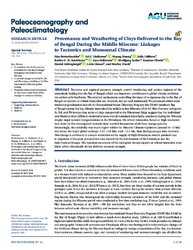Provenance and Weathering of Clays Delivered to the Bay of Bengal During the Middle Miocene: Linkages to Tectonics and Monsoonal Climate
Bretschneider, Lisa; Hathorne, Ed C.; Huang, Huang; Lübbers, Julia; Kochhann, Karlos G. D.; Holbourn, Ann; Kuhnt, Wolfgang; Thiede, Rasmus; Gebregiorgis, Daniel; Giosan, Liviu; Frank, Martin, 2021: Provenance and Weathering of Clays Delivered to the Bay of Bengal During the Middle Miocene: Linkages to Tectonics and Monsoonal Climate. In: Paleoceanography and Paleoclimatology, Band 36, 2, DOI: 10.23689/fidgeo-4411.
 |
Dokument öffnen: |
Tectonics and regional monsoon strength control weathering and erosion regimes of the watersheds feeding into the Bay of Bengal, which are important contributors to global climate evolution via carbon cycle feedbacks. The detailed mechanisms controlling the input of terrigenous clay to the Bay of Bengal on tectonic to orbital timescales are, however, not yet well understood. We produced orbital‐scale resolution geochemical records for International Ocean Discovery Program Site U1443 (southern Bay of Bengal) across five key climatic intervals of the middle to late Miocene (15.8–9.5 Ma). Our new radiogenic Sr, Nd, and Pb isotope time series of clays transported to the Ninetyeast Ridge suggest that the individual contributions from different erosional sources overall remained remarkably consistent during the Miocene despite major tectonic reorganizations in the Himalayas. On orbital timescales, however, high‐resolution data from the five investigated intervals show marked fluctuations of all three isotope systems. Interestingly, the variability was much higher within the Miocene Climatic Optimum (around 16–15 Ma) and across the major global cooling (~13.9–13.8 Ma) until ~13.5 Ma, than during younger time intervals. This change is attributed to a major restriction on the supply of High Himalayan erosion products due to migration of the peak precipitation area toward the frontal domains of the Himalayas and the Indo‐Burman Ranges. The transient excursions of the radiogenic isotope signals on orbital timescales most likely reflect climatically driven shifts in monsoon strength. Key Points:
A consistent mix of clay sources contributed to the Bay of Bengal throughout the middle to late Miocene
A marked change in detrital Sr, Nd, and Pb isotope variability at 13.5 Ma was related to Miocene global cooling
Transient orbital‐scale fluctuations in clay source most likely reflect changes in monsoon intensity
Statistik:
ZugriffsstatistikSammlung:
- Geologie [933]
This is an open access article under the terms of the Creative Commons Attribution License, which permits use, distribution and reproduction in any medium, provided the original work is properly cited.

